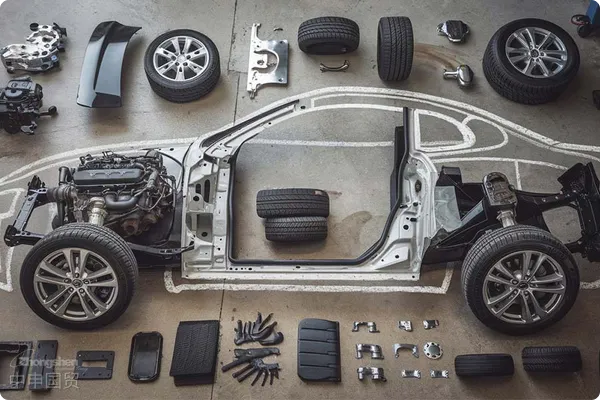- Shanghai Zhongshen International Trade Co., Ltd. - Two decades of trade agency expertise.
- Service Hotline: 139 1787 2118

I. RetailAutomotive partsCurrent Market Situation and Challenges of Imports
With China's car ownership exceeding 350 million vehicles (2023 data), the demand for aftermarket parts continues to grow, making imported overseas brand parts a profit driver for retailers. However, significant industry pain points remain:
1.High category complexity: Engine components, electronic systems, exterior modification parts, etc., must comply with different regulatory standards;
2.Concentration of compliance risks: EU e-mark certification, US DOT certification, China3CCross-referencing of directories and other regulatory oversight;
3.Supply chain long-tail effect: Small-batch, multi-frequency procurement leads to logistics costs accounting for 25%-30% of total expenses;
4.Terminal competition intensifies.: The price war on e-commerce platforms is forcing importers to optimize procurement costs.
II. Comprehensive Breakdown of the Automotive Parts Import Process (Taking China as an Example)
Phase 1: Preliminary Risk Control Planning
1.Pre - classification of Goods
- In accordance with the "People's Republic of China"import and exportThe Customs Tariff accurately identifies HS codes (e.g., other motor vehicle parts and accessories under 8708.99).
- Typical case: The tariff difference between turbochargers (8414.8090) and exhaust systems (8708.92) reaches 8%.
2.Prequalification for Access Qualifications
- Mandatory Certification Verification: The 2023 Updated CCC Catalog Covers 12 Categories of Auto Parts Including Brake Pads and Seat Belts
- Intellectual property record filing: Preventing trademark infringement of OEM parts (e.g., BMW filter anti-counterfeiting code verification)
Phase 2: International Procurement Execution
1.Trade Term Selection
- It is recommended to purchase under FOB terms.Maritime TransportationRisk (CIC clauses cover risks of accessory rust damage and packaging deformation)
- Under DDP terms, destination port charges must be calculated (taking a 40HQ container as an example: port THC + documentation fee is approximately ¥3800).
2.Optimization of Origin Strategy
- ASEAN FORM E Certificate (some parts enjoy 0% tariff)
- China-Europe Railway ExpressComparison of Delivery Time: Poland Line 21 days vs. Sea Freight 35 days (2023 Market Quotation)
Phase 3: Key Customs Clearance Nodes
1.Declaration element management
- The engine piston must declare the material (aluminum alloy/cast iron) and applicable displacement (e.g., 1.5L ≤ displacement ≤ 2.0L).
- The modification of wheel hubs requires the submission of design drawings as evidence of non-infringement.
2.Accurate tax calculation
- Comprehensive tax rate formula: VAT 13% + Customs duty (based on HS code) + Consumption tax (applicable to specific categories only)
- Case: The comprehensive tax rate for imported Japanese wiper blades (8708.50) is approximately 18.7%.
Phase 4: Domestic Distribution Layout
1.Bonded warehouse applications
- Cross-border E-commerce1210 model stock preparation (single item value ≤ ¥5000 eligible for postal tax benefits)
- Regional Warehouse Planning: Logistics Cost Comparison Between East China (Shanghai/Ningbo) and South China (Nansha, Guangzhou)
2.Utilize the China - ASEAN Free Trade Agreement (ACFTA) to reduce tariffs, and a Form E certificate of origin is required.
- Establish an EPC electronic catalog (vehicle compatibility database)
- Design of Return and Repair Solution (Application for Customs Bond Reduction)
III. Industry Experience: 5 Practical Strategies for Cost Reduction
1.Container Loading Optimization
- Irregular accessories are loaded using suspended brackets (increasing volume utilization by 15%-20%).
- Fragile Item Packaging Standard: ISTA 3E Test Certification + Humidity Indicator Card
2.Tariff reduction pathways
- Enterprises applying for AEO certification enjoy a reduced inspection rate of 0.8%.
- Under the RCEP framework, the import tariff on spark plugs from South Korea will be gradually reduced from 8% to zero year by year.
3.Supply chain financial tools
- L/CFinancing (Extending the payment term to 90 days by utilizing the document presentation period)
- Tariff Guarantee Insurance as a Substitute for Cash Deposit (Relieving 90% of Financial Pressure)
4.Digital Risk Control System
- Blockchain Traceability (Recording the entire chain of production, transportation, and quality inspection for components)
- Big Data Alert (Monitoring HS Code Adjustments and Anti-Dumping Investigation Trends)
5.Differentiated Product Selection Matrix
- Long-tail products:New energyAutomotive Special Part (Charging Port Protective Cover)
- High-value-added products: Racing-grade modification kits (gross profit margin exceeding 60%)
IV. Typical Case: Review of a German Brake Pad Import Project
Products with paint coatings were detained by the Los Angeles Customs for CPSC lead content sampling inspection:
- The product involves dual requirements of EU ECER90 certification and China GB5763.
- Claims Dispute Over Wet Damage During Ocean Shipping
Solution:
- Submit the technical document comparison report to the China Certification Centre for Automotive Products (CCAP) in advance.
- Activate the temperature-controlled container (20°C±2°C) with an additional IPPC fumigation certificate.
- Lock the classification conclusion (HSCODE 8708.39) through the pre-ruling system.
Achievements:
- Customs clearance time reduced to 2 working days.
- The cargo damage rate decreased from 3.2% to 0.5%.
- Annual procurement costs decreased by 14%.
V. Future Trends: Digital Transformation Reshapes the Industry Ecosystem
1.Intelligent classification system: AI automatically matches HS codes (with an accuracy rate of 98.6%)
2.Cross-border supply chain visualization: IoT devices monitor temperature/humidity/vibration data in real time
3.Compliance Automation Platform: One-click generation of multi-country certified technical documentation
Conclusion:
The import of automotive parts has transitioned from the "era of trade price differentials" to the "era of supply chain value competition." Selecting an agent service provider with full-chain service capabilities, a localized customs clearance network, and familiarity with automotive industry policies will be key for retailers to establish core competitiveness. It is recommended that enterprises focus on the dual-drive model of "compliance cost control" and "endpoint data empowerment" when planning their strategies, to address the regulatory challenges posed by upcoming upgrades such as the EU's new Battery Regulation and the U.S. Supply Chain Traceability Act set to be implemented in 2024.
Related Recommendations
? 2025. All Rights Reserved. Shanghai ICP No. 2023007705-2  PSB Record: Shanghai No.31011502009912
PSB Record: Shanghai No.31011502009912









